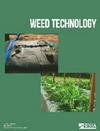Control of Giant Ragweed (Ambrosia trifida) in Mesotrione-Resistant Soybean
IF 1.7
3区 农林科学
Q3 AGRONOMY
引用次数: 0
Abstract
Preemergence (PRE) applications of mesotrione, a herbicide that inhibits 4-hydroxyphenolpyruvate dioxygenase (HPPD), have recently gained regulatory approval in appropriately traited soybean varieties. Giant ragweed is an extremely competitive broadleaf weed, and biotypes resistant to acetolactate synthase inhibitors (ALS-R) can be particularly difficult to manage with soil-residual herbicides in soybean production. This study investigated control of giant ragweed from PRE applications of cloransulam (32 g ai ha控制抗中耕松大豆中的大豚草(Ambrosia trifida)
萌芽前(PRE)施用美索三酮(一种抑制 4- 羟基苯酚丙酮酸二氧酶 (HPPD) 的除草剂)最近获得了监管部门的批准,可用于适当性状的大豆品种。巨型豚草是一种竞争性极强的阔叶杂草,对乙酰乳酸合成酶抑制剂(ALS-R)产生抗性的生物型在大豆生产中尤其难以用土壤残留除草剂进行管理。本研究调查了在两个不同的地点,通过采用阶乘设计,在两年内预先施用氯酯磺草胺(32 g ai ha-1)、嗪草酮(315 g ai ha-1)和 S-甲草胺(1600 g ai ha-1),同时施用或不施用甲草胺(177 g ai ha-1)对巨豚草的控制情况。此外,还将使用介草酮的处理方法与两种商业预混料产品进行了比较:磺草酮(283 克/公顷)和氯虫苯甲酰胺(37 克/公顷),以及杀草隆(19 克/公顷)、氟吡氧乙酸(69 克/公顷)和吡唑醚菌酯(87 克/公顷)。在种植后 42 天,与未施用介草酮的处理相比,施用介草酮的处理对巨型豚草的控制和生物量的减少都更大。与未施用介草酮的处理相比,施用介草酮的处理大豚草生物量减少了 84%,而未施用介草酮的处理生物量没有减少。在施用这些预除草剂后,利用草铵膦(655 克活性成分/公顷-1)加福美双(266 克活性成分/公顷-1)和 S-甲草胺(1217 克活性成分/公顷-1)的出苗后(POST)除草剂进行连续除草处理,可在种植后 42 天控制至少 97% 的巨型豚草,在 4 个地点年中的 3 个地点年,控制效果优于单独施用草铵膦。在大豆除草剂计划中,在播种前施用介草酮可以有效控制大豚草,通过提供额外的有效除草剂作用点,有可能改善杂草控制并延缓除草剂抗药性的产生。
本文章由计算机程序翻译,如有差异,请以英文原文为准。
求助全文
约1分钟内获得全文
求助全文
来源期刊

Weed Technology
农林科学-农艺学
CiteScore
2.90
自引率
21.40%
发文量
89
审稿时长
12-24 weeks
期刊介绍:
Weed Technology publishes original research and scholarship in the form of peer-reviewed articles focused on understanding how weeds are managed.
The journal focuses on:
- Applied aspects concerning the management of weeds in agricultural systems
- Herbicides used to manage undesired vegetation, weed biology and control
- Weed/crop management systems
- Reports of new weed problems
-New technologies for weed management and special articles emphasizing technology transfer to improve weed control
-Articles dealing with plant growth regulators and management of undesired plant growth may also be accepted, provided there is clear relevance to weed science technology, e.g., turfgrass or woody plant management along rights-of-way, vegetation management in forest, aquatic, or other non-crop situations.
-Surveys, education, and extension topics related to weeds will also be considered
 求助内容:
求助内容: 应助结果提醒方式:
应助结果提醒方式:


